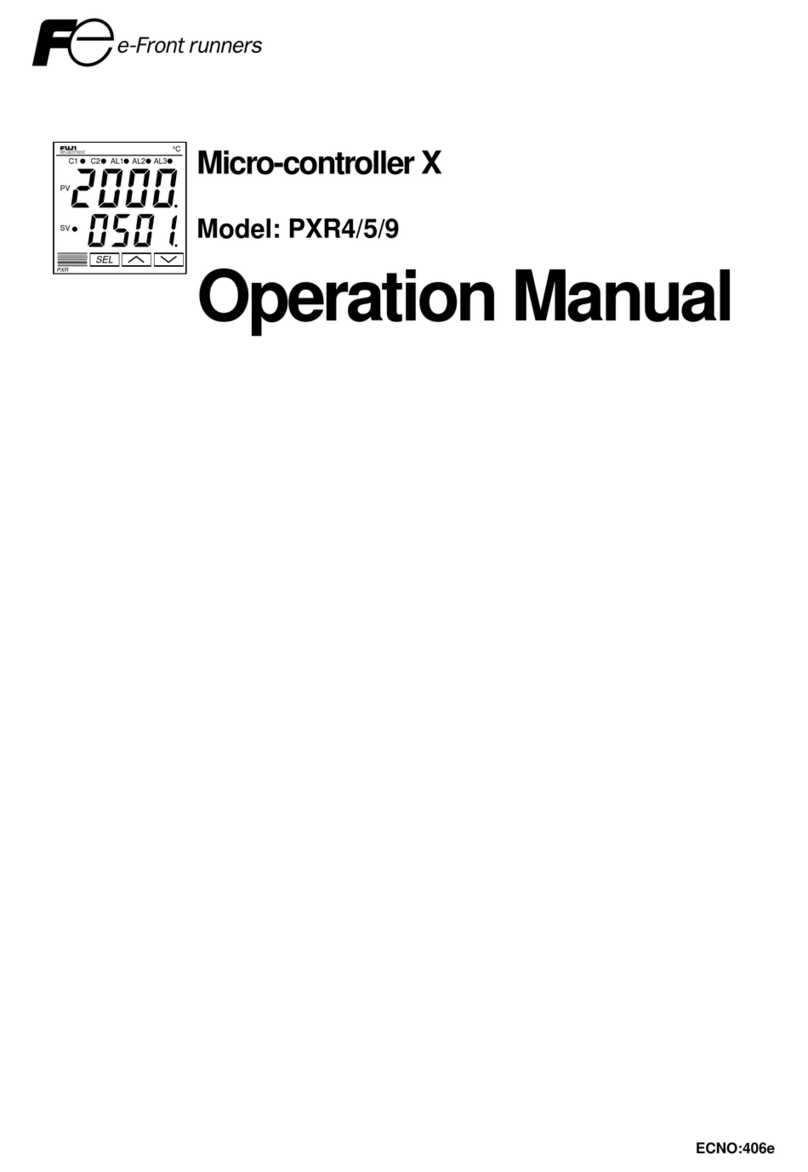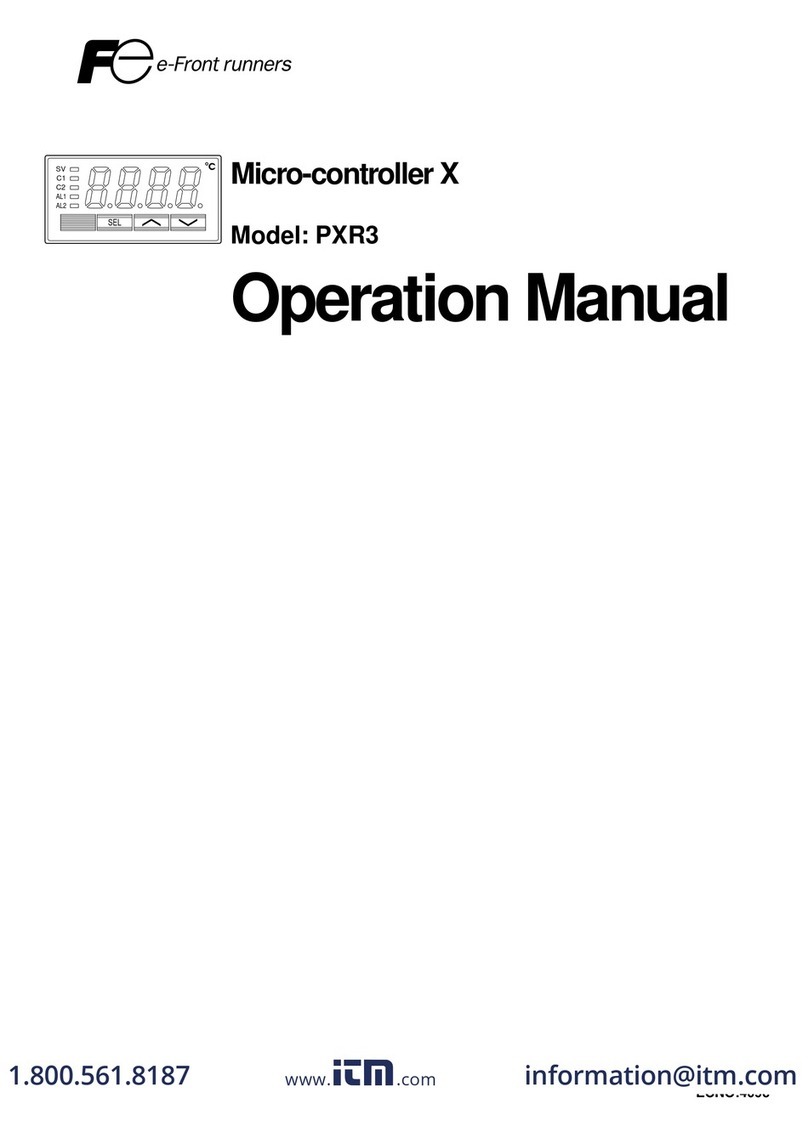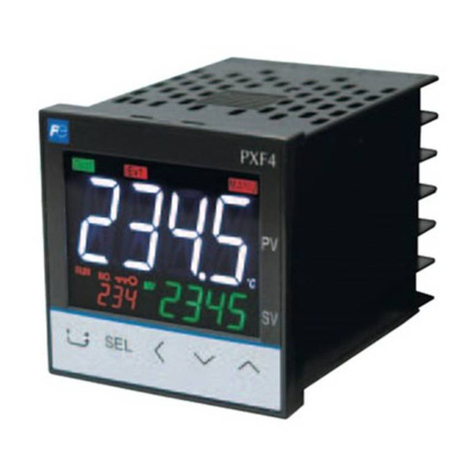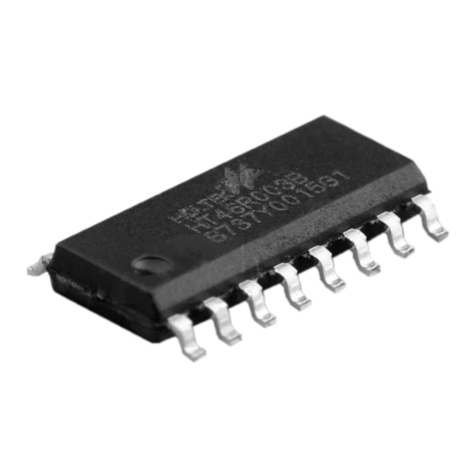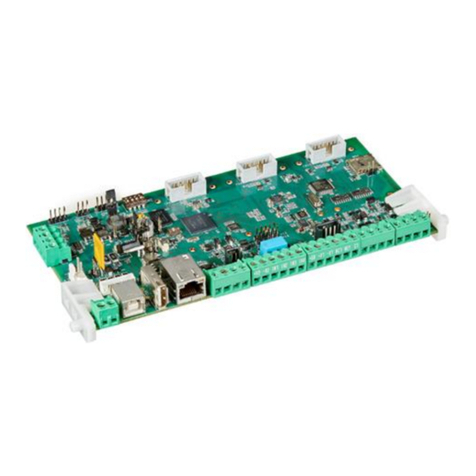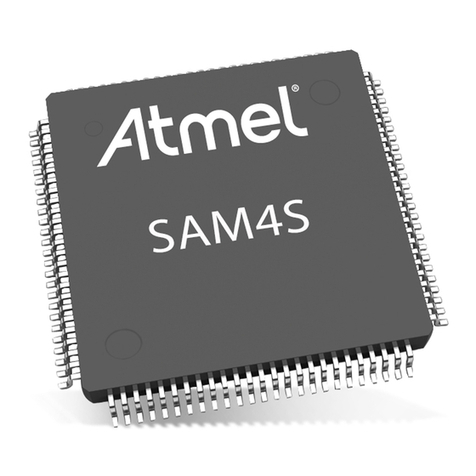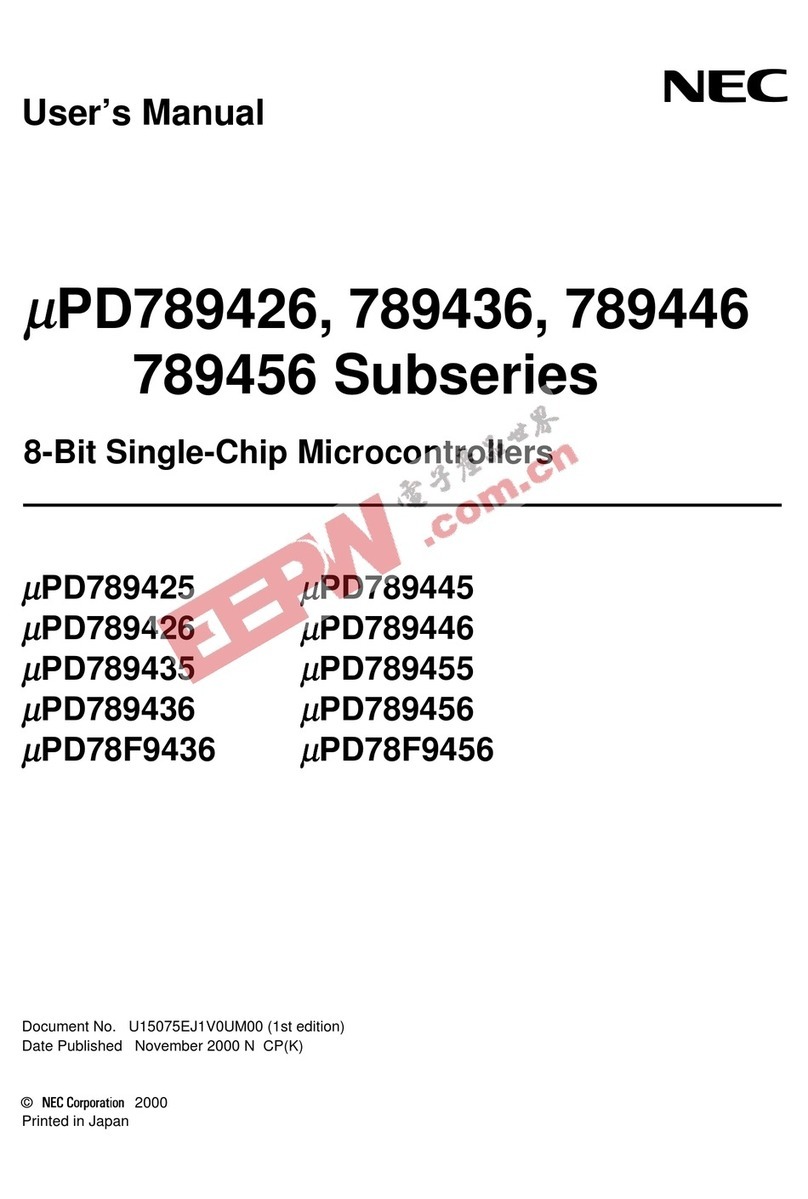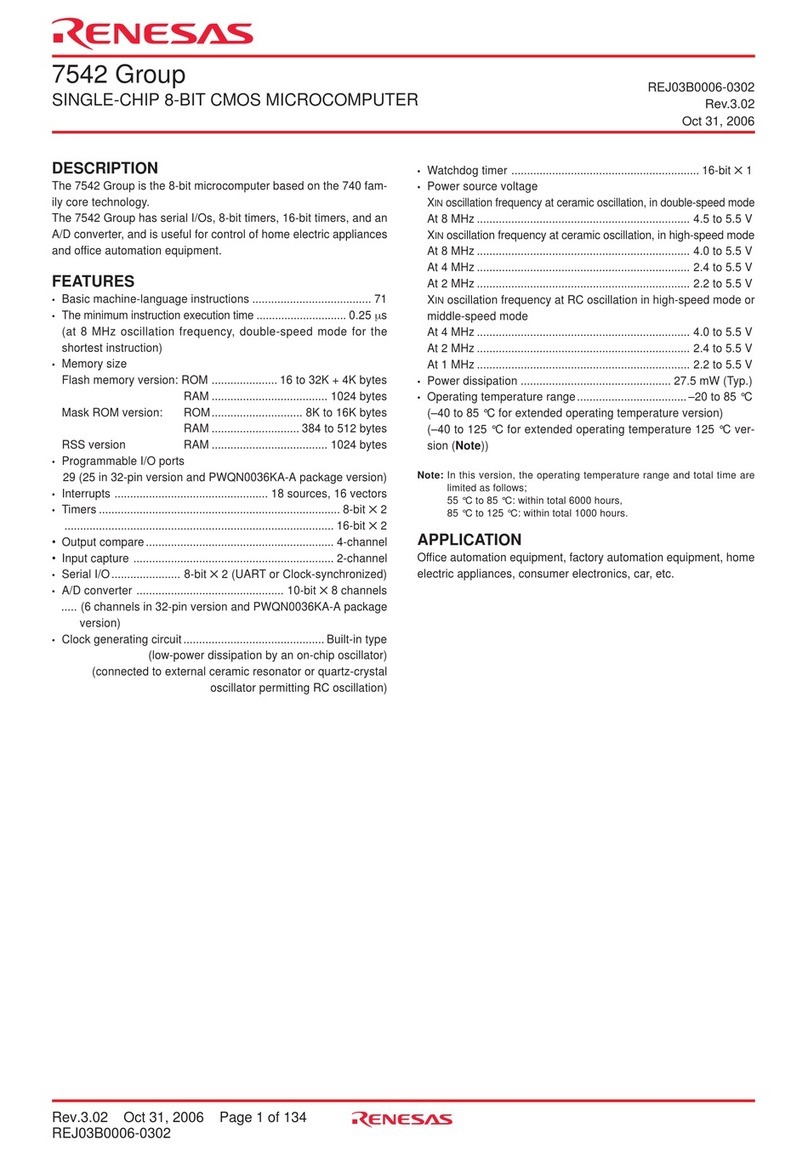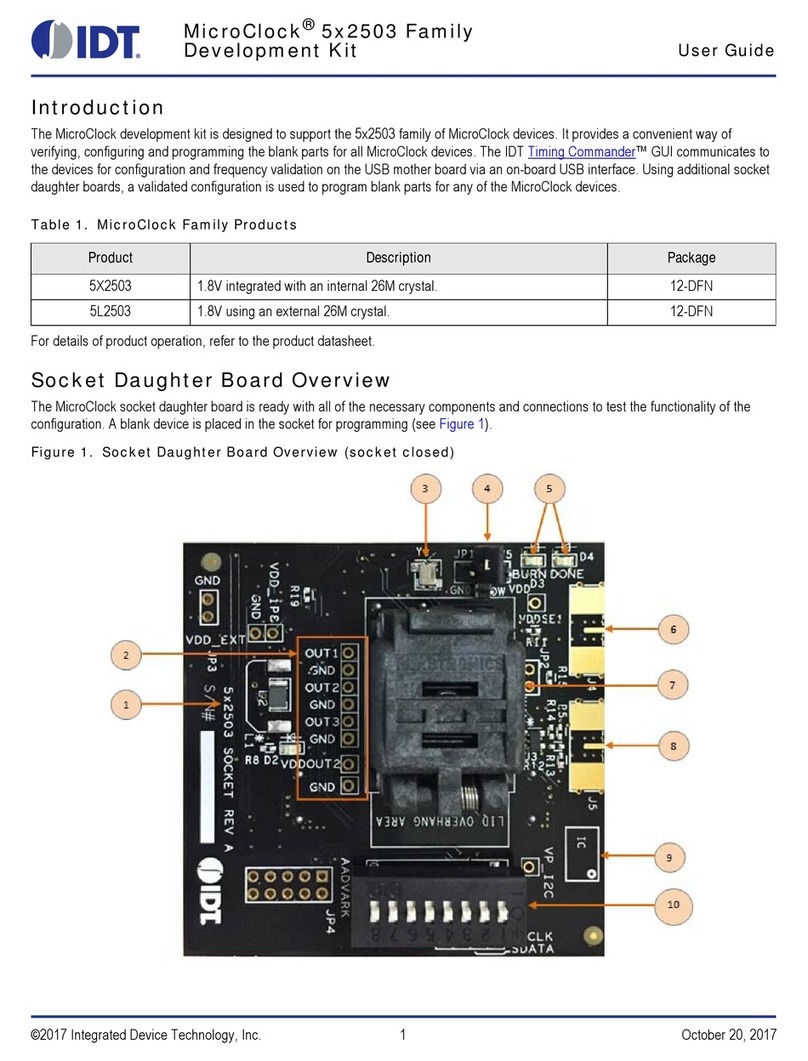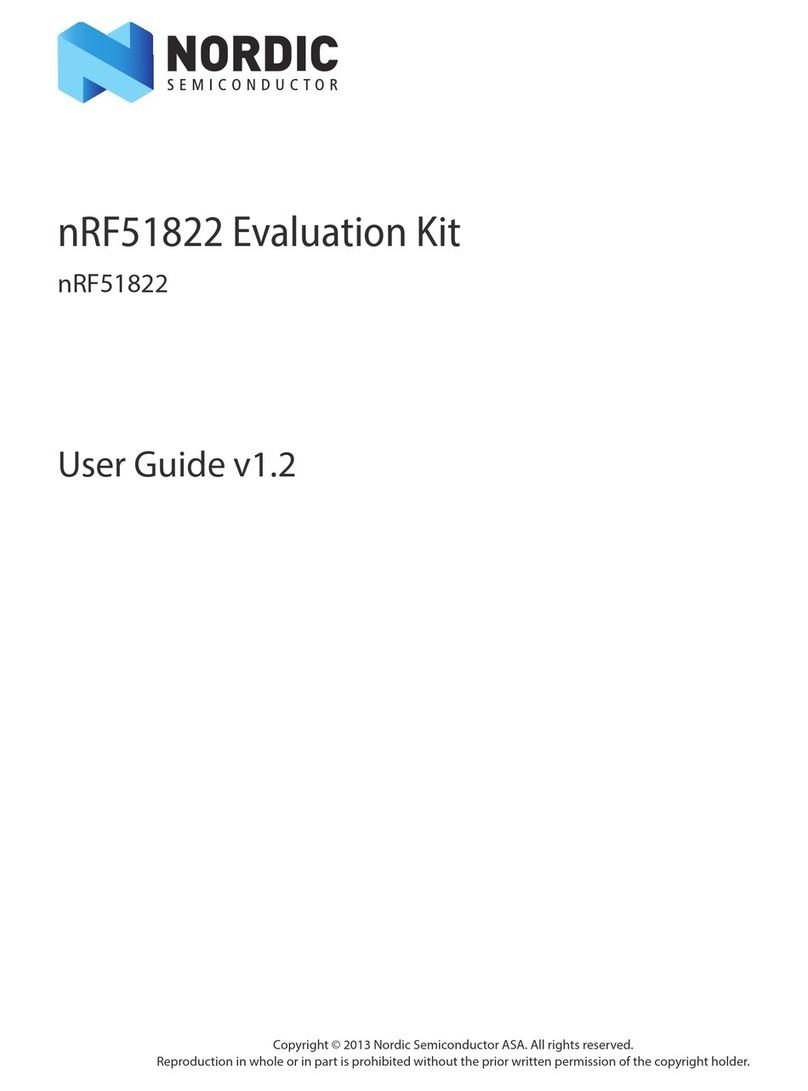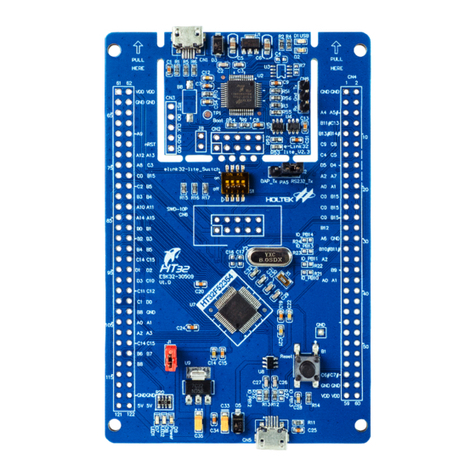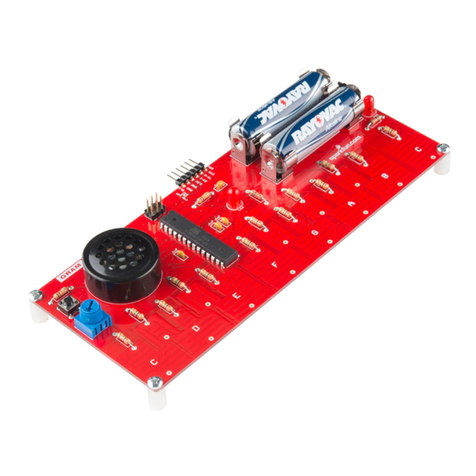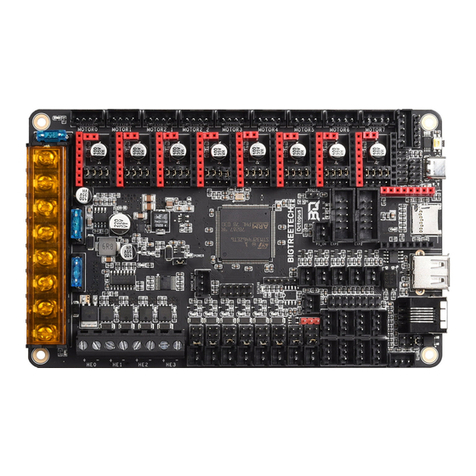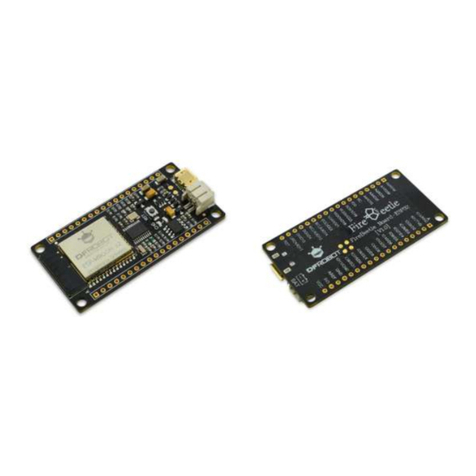Fuji Electric Model: PXR4 User manual

– 1 –
Thank you for your purchasing“Fuji Digital Temperature Controller”. Please check that the product is exactly the
one you ordered and use it according to the following instructions. (Please refer to a separate operation manual
for details.) Dealers are cordially requested to ensure the delivery of this Instruction Manual to hands of the end-
users.
NOTICE
The contents of this document may be changed in the future without prior notice.
We paid the utmost care for the accuracy of the contents. However, we are not liable for direct and indirect
damages resulting from incorrect descriptions, omission of information, and use of information in this docu-
ment.
Contents............................................................ 1
Check of specifications and accessories .......... 2
The related documents ..................................... 2
Safety Precautions ............................................ 3
Index ............................................................. 9
1. Installation/mounting ................................... 10
2. Wiring.......................................................... 11
3. Usage.......................................................... 12
4. Display and operation ................................. 13
5. Setting methods of temperature and
parameters........................................... 15
1st block parameter..................................... 15
2nd block parameter ................................... 16
3rd block parameter .................................... 17
6. Functions .................................................... 18
6-1 ON/OFF control ................................. 18
6-2 Auto-tuning......................................... 19
6-3 Self-tuning............................................. 20
6-4 Alarm function [option] .......................... 22
6-5 Ramp/soak function [option] ................. 24
6-6 Communication function [option] .......... 25
6-7 Digital input (DI function) [option].......... 26
6-8 Other function ....................................... 27
6-9 Re-transmission output function ........... 28
6-10 Remote SV function.............................. 28
7. Setting of input type and control algorithm..... 29
8. Error indications ............................................. 31
[Table 1] Input type code ................................ 32
[Table 2] Control output action code............... 32
[Table 3] Input range (Standard range) .......... 33
[Table 4] Alarm action type code.................... 34
[Table 5] Control operation type code ............ 35
PXR Model Code Cofiguration....................... 36
Specification................................................... 37
Instruction Manual
Micro-controller X
Model : PXR4
INP-TN1PXRe-E
CONTENTS
Head office
6-17, Sanbancho, Chiyoda-ku, Tokyo 102-0075,
Japan
http://www.fesys.co.jp/eng
Sales Div.
International Sales Dept.
No.1, Fuji-machi, Hino-city, Tokyo 191-8502,
Japan
Phone: 81-42-585-6201, 6202 Fax: 81-42-585-6187
http://www.fic-net.jp/eng

– 2 –
Before using the controller, check if the type and specifications are as ordered.
(A table of Model code configuration is given in Page 35).
Check that all of the following accessories are included in the package box.
Check of specifications and accessories
· Temperature controller 1 unit
· Instruction manual 1 copy
· Mounting fixtures 1 pc.
· I/V unit (250Ωresistor) 1 pc. (4-20mA DC input type only)
· Watertight packing 1 pc.
The related documents
Contents
Specifications
Operation method
Communication
functions
Name
Catalogue
MICRO-CONTROLLER X
(Model:PXR)
OPERATION MANUAL
COMMUNICATION FUNCTIONS
(MODBUS)
INSTRUCTION MANUAL
COMMUNICATION FUNCTIONS
(Z-ASCII)
INSTRUCTION MANUAL
Document No.
ECNO:1125
ECNO:406
INP-TN512642-E
INP-TN512644-E

– 3 –
“Any control system design should take into account that any part of the system has the potential to fail”.
“For temperature control systems, continued heating should be considered the most dangerous condition,
and the machine should be designed to automatically stop heating if unregulated due to the failure of the
control unit or for any other reason”.
The following are the most likely causes of unwanted continued heating:
1) Controller failure with heating output constantly on
2) Disengagement of the temperature sensor from the system
3) A short circuit in the thermocouple wiring
4) A valve or switch contact point outside the system is locked to keep the heat switched on.
In any application where physical injury or destruction of equipment might occur, we recommend the instal-
lation of independent safety equipment, with a separate temperature sensor, to disable the heating circuit in
case of overheating.
The controller alarm signal is not designed to function as a protective measure in case of controller failure.
Safety Precautions
WARNING
Over-temperature Protection
Before using this product, the user is requested to read the following precautions carefully to ensure the
safety. Safety precautions must be taken by every user to prevent accidents.
The safety requirements are classified into “Warning” and “Caution” according to the following interpreta-
tions :
Warning Suggesting that the user's mishandling can
result in personal death or serious injury.
Caution
Suggesting that the user's mishandling can result
in personal injury or damage to the property.

– 4 –
1. Warning
1.1 Installation and wiring
•This controller designed to be installed at the following conditions.
•The controller must be installed such that with the exception of the connection to the mains, creepage
and clearance distances shown in the table below are maintained between the temperature probe
and any other assemblies which use or generate a voltage shown in the table below.
Failure to maintain these minimum distances would invalidate the EN 61010 safety approval.
•If the voltage shown above exceeds 50Vdc (i.e.hazardous voltage), the basic insulation is required
between all terminals of this controller and the ground, and supplementary insulation is required for
the alarm output.
Isolation class of this controller is as shown below. Be sure to check that the isolation class of the
controller satisfies your requirements before installation.
Operating temperature
-
10 to +50 [°C ]
Conforming to IEC1010-1
Installation category II
Pollution degree 2
Operating humidity 90%RH or less (Non condensation)
Up to 50Vrms or Vdc
Voltage used or generated
by any assemblies Clearance
(mm) Creepage
(mm)
0.2
Up to 150Vrms or Vdc 0.5
Up to 300Vrms or Vdc 1.5
Above 300Vrms or Vdc Contact with our sales office.
Up to 100Vrms or Vdc 0.2 1.2
1.6
3.0
1.4
Mains (Power source) Measured value input, CT input, Remote SV input
Control output1 (relay output) Internal circuit
Control output2 (relay output) Control output1, 2 (SSR drive output / Current output)
Alarm outout (AL1) Re-transmission
Alarm outout (AL2) Communication (RS-485) circuit
Alarm outout (AL3) or Digital input (DI).
Heater burnout alarm output (HB)
: Basic insulation, : Non-insulation, : Functional insulation

– 5 –
•If there is a danger of a serious accident resulting from a failure or a defect in this unit, provide the unit
with an appropriate external protective circuit to prevent an accident.
• The unit is normally supplied without a power switch and fuses.
Make wiring so that the fuse is placed between the main power supply switch and this controller.
(Main power supply: 2 pole breaker, fuse rating: 250V, 1A)
• When wiring the power supply terminal, use vinyl insulated 600 volt cable or equivalent.
•To avoid the damage and failure of controller, supply the power voltage fitting to the rating.
•To avoid an electric shock and controller failure, do not turn ON the power before all wiring is com-
pleted.
•Be sure to check that the distance is kept to avoid electric shock or firing before turning the power ON.
•Keep away from terminals while the circuit is energized in order to avoid an electric shock and a
malfunction.
•Never attempt to disassemble, fabricate, modify, or repair this unit because tampering with the unit
may result in a malfunction, electric shock, or a fire.
1.2 Maintenance precautions
•Be sure to turn off the power before this controller is installed or removed in order to avoid an electric
shock, malfunction, and fault.
• Regular maintenance is recommended a longer service life of this controller.
Some parts of this controller have a limited life span, or they will be deteriorated with the lapse of time.
•One-year warranty is guaranteed for this unit including accessories, provided that the controller is
properly used.

– 6 –
2. Caution
2.1 Cautions on installation
Avoid the following places for installation.
•aplace where the ambient temperature may reach beyond the range of from 0 to 50°C while in
operation.
•aplace where the ambient humidity may reach beyond the range of from 45 to 85% RH while in
operation.
•aplace where a change in the ambient temperature is so rapid as to cause condensation.
•aplace where corrosive gases (sulfide gas and ammonia gas, in particular) or combustible gases are
emitted.
•aplace where the unit is subject directly to vibration or shock.
(Vibration or shock may cause output relay malfunction.)
•aplace exposed to water, oil, chemicals, steam and vapor.
(if immersed with water, take the inspection by sales office to avoid an electrical leakage and firing)
•aplace where the unit is exposed to dust, salt air, or air containing iron particles.
•aplace where the unit is subject to intereference with static electricity, magnetism, and noise.
•aplace where the unit is exposed to direct sunlight.
•aplace where the heat may be accumulated due to the radiation of heat.
2.2 Caution on installation on panel
•Insert the mounting bracket (accessory) from the rear side until the main unit is securely fit into the
panel. If there should be a play, tighten two screws lightly until the play is eliminated. (Do not tighten
the screws excessively be cause the mounting bracket can be removed from the stopper by the force.)
•The front side of this controller conforms to NEMA 4X(equivalent with IP66). To ensure the water-
proofness between the instrument and the panel, use packings that are provided as accessories in
the following manner:(The improper fitting of packings will ruin the waterproofness.)
qAs shown in Figure 1, fit a packing to the case of the unit and then insert it in the panel.
wTighten screws on the fixing frame or fixtures so that no gaps are given between the front of control-
ler and packing and between panels. Check that there are no deviation and deformation of packing as
shown in Fig.3.
•If panel strength is weak, it may causes a gap between the packing and the panel, thus impairing
water resistance.
No.000001T
PXR4TAA1-1YM00-D
MFD2000-04
No.000001T
PXR4TAA1-1YM00-D
MFD2000-04
Figure 1 Figure 2
Unit Unit
Front Case Panel
PackingPacking
Panel Mounting
bracket Screw
Figure 3
Packing Packing
Case Case
(Bad) (Good)

– 7 –
Standard :Vertical mounting, flush on the panel. (The controller is horizontal.)
When mounting the controller on tilted surface, the maximum tilt angle is 30°(degree) from virtical.
α=0to30°
(Caution)
•Don’t block the openings around the controller, or radiation effect will be re-
duced.
• Don’t block the ventilation openings at the top of the terminal block.

– 8 –
2.3 Precautions in wiring connection
•For the thermocouple sensor type, use thermocouple compensation wires for wiring.
For the RTD type, use a wiring material with a small lead wire resistance and no resistance differen-
tials among three wires.
•Keep input lines away from power line and load line to avoid the influence from noise induced.
•For the input and output signal lines, be sure to use shielded wires and keep them away from each
other.
•If a noise level is excessive in the power supply, the additional installation of an insulating transformer
and the use of a noise filter are recommended.
(example:ZMB22R5-11 Noise Filter manufactured by TDK)
Make sure that the noise filter is installed to a place such as a panel that is properly grounded. The
wiring between the noise filter output terminal and the instrument power supply terminal should be
made as short as possible. None of fuses or switches should be installed to the wiring on the noise
filter output side because the filter effect will be degraded by such an installation.
•Abetter anti-noise effect can be expected by using stranded power supply cable for the instrument.
(The shorter the stranding pitch is, the better the anti-noise effect can be expected.)
•For the unit with an alarm against a failure (burn-out) in the heater, use the same power line for
connection of the power supplies for the heater and the controller.
•Asetup time is required for the contact output when the power is turned on. If the contact output is
used as a signal for an external interlock circuit, use a delay relay at the same time.
•Use the auxiliary relay since the life is shortened if full capacity load is connected to the output relay.
SSR/SSC drive output type is preferred if the output operations occur frequently.
[Proportional interval] relay output: 30 seconds or more,
SSR/SSC: one second or more
•If inductive load such as magnetic switches connected as a relay output load, it is recommended to
use Z-Trap manufactured by Fuji Electric to protect a contact from switching serge and keep a longer
life.Model : ENC241D-05A (power supply voltage: 100V)
ENC471D-05A (power supply voltage: 200 V)
Where to install : Connect it between contacts of the relay control output.
2.4 Requirement for key operation/operation in abnormalities
•Prior to the operation, be sure to check alarm functions, since a failure in the proper setting will result
in a failure in the proper output of an alarm in case of an abnormality.
•Adisplay of UUUU or LLLL will appear in case of a break in the input. Be sure to turn off the power
when a sensor is replaced.
2.5 Others
•Do not use organic solvents such as alcohol and benzine to wipe this controller. Use a neutral deter-
gent for wiping the controller.
Z-Trap connection
1 7
13
2 8
14
3 9
15
4
10 16
5
11 17
6
12 18
Example)

– 9 –
Index
(Note) *To start the operation, wait for about 30 minutes after the power-on for warm up.
<Reference items> <Description>
Error indications
8
Power on
Wiring
2
Usages
3
Display and operation
4
Setting method of temperature and parameters
5
Functions
6
Setting of input type and control algorithm.
7
Operation
Installation/mounting
1
Confirming type specification • Confirming that the delivered
controller is equal to the ordered
one.
• Outline dimensions
• Panel cutout dimensions
• Mounting method on the panel
• Set value change method
• Basic operation method
• List of parameters
• List of input/output/alarm codes
• Setting of input type and ranges
• Selecting of control method
• Terminal connection diagram
*Note

– 10 –
1 Installation/mounting
Outline and Panel Cutout Dimensions
63 or more
73 or more
+0.5
a
-0
Number
of units
23456
a93141 189 237 285
45
+0.5
0
45
+0.5
0
45
+0.5
0
For side by side installation,
see the Note1.
No. 000001T
PXR4TAA1-1YM00-D
MFD 2000-04
AL2AL1C1 C2 AL3
SEL
PXR-4
SV
PV
48
44.8
44.8
79.88
48
Mounting bracket
Panel
Panel thickness 1 to 8mm
Packing
48
44.8
57
6.2
Terminal screw M3×6
13
16
17
18
14
15
7
8
10
11
12
9
1
2
4
5
6
3
Outline dimensions (unit:mm) Panel cutout dimensions
(unit:mm)
Cautions on wiring •Wiring should be started from the left side terminal (No. 1 to No.6).
•Use crimped terminals matched to the screw size. Tightening torque should be about
0.8 N·m (Since the case is made of plastic, do not tighten excessively).
•Do not connect anything to terminals not used.
Note 1
Caution on side by side installation
• With the power supply of 200VAC or more, a maximum ambient temperature is 45˚C.
(It is recommended to use a fan for cooling.)
When there is another instrument (larger than 70mm) or a wall on the right side of this controller, be
sure to install the controller keeping a space of more than 30mm.
Wateproofness cannot be ensured in the case of side-by-side installation.
30 min.
70 or more

– 11 –
2Wiring
u
i
o
!0
!1
!2
Relay output
CT input
!1
!2
!1
!2
Control output2
SSR/SSC drive output
Current output
+
-
Digtal input
CT input
CT input
RS485 com.
+
-
Digtal input
RS485 com.
+
-
Remote SV input
RS485 com.
+
-
Remote SV input
Digtal input
u
i
Re-transmission output
Re-transmission output
+
-
u
i
Digtal input
Remote SV input
+
-
+
-
u
i
u
i
u
i
u
i
u
i
o
!0
o
!0
!1
!2
!1
!2
o
!0
o
!0
o
!0
o
N.C.
DI1
DI2
Digtal input
!0
+
-
!1
!2
+
-
!1
!2
· Common
· Alarm output1 (AL1)
· Alarm output2 (AL2)
· Heater break
Alarm output3 (AL3)
50/60Hz
Control output1
Alarm output
Power supply
(Note2)
(Note1)
Relay output
Thermocouple
Resistance bulb Current/voltage
Current output
uq!3
iw!4
oe!5
!3
!4
!3
!4
!3
!4
!5
+A
B
B
-
+
-
+
-
+
-
!0r
q
w
e
r!6
!1t!7
!2y
t
y
!8
!6
!7
!8
!7
!8
!7
!8
100-240V AC
SSR/SSC drive output
Measured value input
Note 1 : Check the power supply voltage before installation.
Note 2 : Connect the I/V unit (250Ωresistor) (accessory)
betweenthe terminal !7 and !8 in case of current
input.
In the case of 1 digital input
point (the 11th, 12th, or 13th
digit of the code symbol is “S00”),
connect the digital input terminal
between terminals uand i.
In the case of 2 digital input points + heater break alarm,
or 2 digital input points + remote SV specifications, connect the CT
input and remote input terminals between terminals !1 and !2.
t
y
24V AC/DC
+
-
Terminal Connection Diagram (100 to 240
AC, 24V AC/24V DC
)

– 12 –
3 Usage (Read before using)
Name of Functional Parts and Functions
AL2AL1C1 C2 AL3
SEL
PXR-4
SV
PV
1
2
3
S1 S2 S3
4
8
765
Model : PXR4
Name Function
Select key The key shifting to the 1st, the 2nd or the 3rd block parameter, switching the display
between parameter and the data at the 1st, the 2nd and the 3rd block.
Setting keys
S1
Down key · The numerical value is decreased by pressing the key once. The numerical value
keeps on decreasing by pressing the key continuously.
· For searching parameters within the 1st, the 2nd and the 3rd block.
S3
Up key · The numerical value is increased by pressing the key once. The numerical value
keeps on increasing by pressing the key continuously.
· For searching parameters within the 1st, the 2nd and the 3rd block.
S2
Name Function
Process value (PV)/parameter
name display 1) Displays a process value (PV).
2) Displays the parameter symbols at parameter setting mode.
3) Displays various error indications (refer to the “8.Error indications”).
Display/Indication
q
Auto-tuning/self-tuning indicator/
manual operation
r
Set value (SV) indication lamp
w
Control output indication lamp
The lamp is lit while a set value (SV) is displayed.
Set value (SV)/parameter setting
display
e1) Displays a set value (SV).
2) Display the parameter settings at parameter setting mode.
3) Flickers at Standby mode.
4) Displays the set value (SV ) and “SV-1” alternately when the SV
witching function is used.
5) Displays the set value (SV) and “rSV”alternately while in remote
operation.
The lamp flickers while the PID auto-tuning or the self-tuning is being
performed.
Kept on during manial operation.
t
Alarm output 1 (AL1)
indication lamp (Note 1)
C1 :The lamp is lit while the control output 1 is ON.
C2 :The lamp is lit while the control output 2 is ON.(Note 1)
y
Alarm output 2 (AL2)
indication lamp (Note 1)
The lamp is lit when the alarm output 1 is activated.
It flickers during ON-delay operation. (Note 2)
uThe lamp is lit when the alarm output 2 is activated.
It flickers during ON-delay operation. (Note 2)
Alarm output 3 (AL3)
indication lamp (Note 1)
iThe lamp is lit while the alarm output 3 or the heater break alarm
output is ON. The lamp flickers while in ON delay operation. (Note 2)
Note 1) Control output 2 and alarm function are optional.
Note 2) The lamp does not flicker while the timer is activated.

– 13 –
4Display and operation
Standby mode
· To perform standby operation, set "STby" as ON in the
1st block parameter.
Caution
Caution
· Standby mode:
(Output) Control outputs (1 and 2) and alarm outputs (all) are not
provided. However, depending on setting of "P-n1", control action, control
outputs are provided at the abnormal input.
No alarm output is provided at standby mode, even in
(Fault-condition).
(Control)Control is not performed.
(Display) SV display flickers.
(Setting) SV and parameter settings are able to perform.
Be careful since the equipment does not provide output of the
alarm of the main unit abnormality during the standby operation.
The SV display does not flicker while the 1st, 2nd and 3rd block
parameters are displayed.
Switching by
1st block
STby settings
Switching by
the key
SEL
AL2AL1C1 C2 AL3
SEL
PXR-4
SV
PV
1
2
3
AL2AL1C1 C2 AL3
SEL
PXR-4
SV
PV
Change of set value (SV)
Shift to the 1st, 2nd and 3rd block parameter
To shift to the other blocks, press the key.
When the SV lamp is lit, the set value
(SV) is displayed at the lower line.
After the data setting, the data are
registered automatically in 3 seconds.
Depending on the pressing time of key,
you can select the block to shift.
The set value (SV) can be changed.
Operation mode
SEL
SEL
SEL
AL2AL1C1 C2 AL3
SEL
PXR-4
SV
PV
Changing operation output value (MV)
Set the " "parameter to "on"
to switch the operation mode to
Manual.The display shown at right
appears.
MV value can be changed by pressing
keys.
Press the key during manual
operation,and the display at the
bottom switches between SV and MV.
The MV value can be changed in
manual operation mode
AL2AL1C1 C2 AL3
SEL
PXR-4
SV
PV
pressing time Shifting block
About 1 sec pressing 1st block
About 3 sec pressing 2st block
About 5 sec pressing 3st block
Caution
Caution
SEL
Press the .
SEL
Press the .
SEL

– 14 –
Note:If the upper display (PV) comes off (or kept distinguished), make the setting once again by adding 64 to the set value of parameter DP13.
Switching by
the key
SEL
AL2AL1C1 C2 AL3
SEL
PXR-4
SV
PV
AL2AL1C1 C2 AL3
SEL
PXR-4
SV
PV
SEL
SEL
SEL
SEL
SEL
SEL
AL2AL1C1 C2 AL3
SEL
PXR-4
SV
PV
1
1
3
2
Press the
once.
Press the for 2 sec. Parameter selection
Parameter setting procedure
Select a parameter you want to
set by pressing the or
key.
3To shift to Operation/Standby
mode, press the key for 2 sec.
2-1Press the key to allow the
parameter to change.
(Under the changing condition,
the parameter set value flickers).
2-2Pressing the or key, to
change the parameter set value.
2-3After the parameter has been
changed, press the key
for registration.
Parameter settings
Shift to operating condition
Parameter search. Parameter change.
By repeating the same procedure, the
parameters can be displayed according to the
parameter list shown in 5, Setting methods of
temperature and parameters.
Operation mode
Parameter setting mode
Press the . Press the .
Increases parameter
set value
Decreases parameter
set value
Registers
parameter set
value,
returning to the parameter
shift mode .
1

– 15 –
5
Setting methods of temperature and parameters
1st block parameter
Press for about 1 sec.
Operation/Standby mode
Control output status
Alarm status
PV value
indication
MV value indication lamp is lit
SV value
indication
When the set value
(SV) is displayed at
the lower line, the
SV lamp is lit.
AL2AL1C1 C2 AL3
SEL
PXR
-
4
SV
PV
Manual
AL2AL1C1 C2 AL3
SEL
PXR
-
4
SV
PV
Standby
AL2AL1C1 C2 AL3
SEL
PXR
-
4
SV
PV
Auto
SEL
Press for about 2 sec.
SEL
Parameter
display symbol Parameter
Standby settings
Description of contents Default
setting
Remarks
STbY
ProG
LACH
AT
TM-2
AL1
A1-L
A2-L
A2-H
LoC
TM-1 Timer 1 display
Timer 2 display
Alarm 1 low limit
set value
Alarm 1 set value
(appears only with alarm action type 16 to 31).
Setting range: Note 1
Alarm 1 high limit
set value
(appears only with alarm action type 1 to 10).
Setting range: Note 1
Alarm 2 set value
10
10
A1-H
AL2
10
10
0
Switches RUN or Standby of the control.
ON: Control standby (output: OFF, alarm: OFF)
OFF: Control RUN
Selecting manual
mode
MAnU Switch the operation mode by selecting Auto/Manual
ON: Manual mode
OFF: Auto mode
OFF: stop, rUn: Start, HLd: status hold
0: Stop, 1: Standard AT start, 2: Low PV type AT start
OFF
Alarm latch cancel Releases alarm latch.
1: Alarm latch release 0
Ramp/soak control
CMod Switches Local and Remote operations.
: Local operation
: Remote operation
Control mode
OFF
Auto-tuning
Time displays indicating the remining time at the timer
mode.
(appears only with alarm action type 1 to 10).
Setting range: Note 1
(appears only with alarm action type 16 to 31).
Setting range: Note 1
(appears only with alarm action type 16 to 31).
Setting range: Note 1
Alarm 2 high limit
set value
(appears only with alarm action type 16 to 31).
Setting range: Note 1
Alarm 2 low limit
set value
Setting of key lock status.Key lock
–
0
–
TM-3 Timer 3 display –
10
Table 4
(Page 33)
Note 1
10
All parameters
Front keyLoC
0
1
2
3
4
5
Comm-
unication
SV
Front key Comm-
unication
Note 1) Setting range : 0 to 100%FS (in case of absolute value alarm)
-
100 to 100%FS (in case of deviation alarm)
· Some parameters may not be displayed on the screen, depending upon the types.
A3-L
A3-H
(appears only with alarm action type 1 to 10).
Setting range: Note 1
Alarm 3 set value
10
AL3
10
10
(appears only with alarm action type 16 to 31).
Setting range: Note 1
Alarm 3 high limit
set value
(appears only with alarm action type 16 to 31).
Setting range: Note 1
Alarm 3 low limit
set value
: Setting enable, : Setting disable
· If no operation status
continues for 30 seconds,
the screen is restored
to the PV/SV display just
after the power is turned on.
OFF

– 16 –
2nd block parameter
· If no operation status
continues for 30 seconds,
the screen is restored
to the PV/SV display just
after the power is turned on.
Parameter
Proportional band
Description of contents Default
setting
Remarks
P
I
D
TC
TC2
CooL
db
P-SU
P-dP
ALM1
ALM3
HYS
Hysteresis for ON/OFF contorol
Cycle time (control output 2)
Deadband/overlap
Proportional band
coefficient on cooling side
Input type code
Lower limit of input range
As ordered
As ordered
P-n2
P-SL
As ordered
As ordered
0/5
0
5.0
Derivative action time 60.0
Integral time (reset) 240
Cycle time (control output1)
Setting types of alarm action (Setting range: 0 to 34)
Setting of decimal point
position
PVOF
0
PV offset
Type of alarm 1
Upper limit of input range
Type of alarm 3
ALM2
0/9
Type of alarm 2
1
30/2 Note 2
30/2
1.0
0.0
PTn
1
Selects the ramp/soak execute type.
1: Executes 1st to 4th segment.
2. Executes 5th to 8th segment.
3. Executes 1st to 8th segment.
Ramp/soak execute type
SV-1
to
SV-8
0%FS
Sets the target SV for each ramp segment.
(Setting range: 0 to 100%FS)
Ramp target SV-1 to SV-8
TM1r
to
TM8r
0.00
Sets the time for each ramp segment.
(Setting range: 0 to 99 hours and 59 minutes)
1st ramp segment time to
8th ramp segment time
TM1S
to
TM8S
0.00
Sets the time for each soak segment.
(Setting range: 0 to 99 hours and 59 minutes)
1st soak segment time to
8th soak segmentl time
STAT
–
Ramp/soak status
Shift the display of process value (PV).
(Setting range: -10 to 10%FS)
Displays the current Ramp/Soak status.
No setting can be made.
Setting range: 0.0 to 999.9%
ON/OFF control when “P” = 0
Setting range: 0 to 3200 sec.
No integral action when “I” = 0
Setting range: 0.0 to 999.9 sec.
No derivative action when “d” = 0
Sets cycle time of control output 1.
(Setting range: 1 to 150 sec)
Setting range: 0 to 50% FS
Sets cycle time of control output 2.
(Setting range: 1 to 150 sec)
Sets the proportional band coefficient on the cooling side.
(Setting range : 0.0 to 100.0)
ON/OFF control when “Cool” = 0
Shifts the output value on the cooling side.
(Setting range: -50.0 to 50.0%)
Lower limit of input range
(Setting range: -1999 to 9999)
Upper limit of input range
(Setting range: -1999 to 9999)
Type of input Table 1
(Page 31)
Table 3
(Page 32)
Table 4
(Page 33)
Select a decimal point position of display.
(Setting range: 0 to 2)
. .
“1”
0 : No decimal point
“2”
CTrL PID
Type of control algorithm.
(Setting range: PID, FUZZY, SELF)
Control algorithm
P-dF Time constant of input filter 5.0
Time constant (Setting range: 0.0 to 900.0 sec.)
Parameter
display symbol
Note 2
Mod
Setting of ramp/soak mode
0Table 5
(Page 34)
Sets ramp/soak operation mode
Press for about 3 sec.
Operation/Standby mode
Control output status
Alarm status
PV value
indication
MV value indication lamp is lit
SV value
indication
When the set value
(SV) is displayed at
the lower line, the
SV lamp is lit.
AL2AL1C1 C2 AL3
SEL
PXR
-
4
SV
PV
Manual
AL2AL1C1 C2 AL3
SEL
PXR
-
4
SV
PV
Standby
AL2AL1C1 C2 AL3
SEL
PXR
-
4
SV
PV
Auto
SEL
Press for about 2 sec.
SEL
Note 2) When using the heater break alarm, set the parameter “TC” to 20 or more.
Set the CT (current transformer) so that it measures the current of the heater connected
to the control output 1.
Disconnection of the control output 2 cannot be detected.
Never set “TC” / “TC2” = 0.
· Some parameters may not be displayed on the screen, depending upon the types.

– 17 –
3rd block parameter
Parameter
Control action
Description of contents Default
setting
Remarks
P-n1
A1hY
A2hY
dLY2
A1oP
A2oP
dLY1 ON delay time of
alarm 1
ON delay time of
alarm 2
Additional function
of alarm 2
Additional function
of alarm 1
Lower limit of SV
(Setting range: 0 to 100%FS)
Lower limit of SV
Upper limit of SV
(Setting range: 0 to 100%FS)
Upper limit of SV
0%FS
100%FS
SV-L
SV-H
0/4 Table 2
(Page 31)
Note 2
6-7
(Page 25)
6-6
(Page 24)
Hysteresis for
alarm 1 Sets ON-OFF hysteresis for alarm output.
(Setting range: 0 to 50%FS)
1
Hysteresis for
alarm 2
ON delay time setting for alarm output
(Setting range: 0 to 9999 sec)
Additional function of alarm output
(Setting range: 000 to 111)
Alarm latch (1:use, 0:not use)
Alarm of error status (1:use 0:not use)
De-energized (1:use 0:not use), Note 3.
0
1
A3hY Hysteresis for
alarm 3 1
0
dLY3 ON delay time of
alarm 3 0
000
000
A3oP Additional function
of alarm 3
000
di-1
CT
–
Indicates the heater current value.Heater current value
0(OFF)
Selects digital input 1 (DI1) function
(Setting range: 0 to 12)
DI1
function
6-7
(Page 25)
di-2
0(OFF)
Selects digital input 2 (DI2) function
(Setting range: 0 to 12)
DI2
function
STno
1
Communication station No. (Setting range: 0 to 255)Station No.
CoM
0
Parity setting Parity setting. Baud rate is fixed at 9600 bps.
(Setting range: 0 to 2)
dSP1
to
dSP13
Parameter mask
Specifying parameter mask
Selects the control action.
Hb
0.0
Sets current value to detect the heater break alarm
(Setting range: 1.0 to 50.0A, 0: OFF)
HB alarm set value
Parameter
display symbol
Note 2) When using the heater break alarm, set the parameter “TC” to 20 or more.
Set the CT (current transformer) so that it measures the current of the heater connected to the control output 1.
Disconnection of the control output 2 cannot be detected.
Never set “TC” / “TC2” = 0.
Note 3) De-energized: Contact opens when the alarm “ON”.
· Some parameters may not be displayed on the screen, depending upon the types.
PCoL
Ao-T
0
Re-transmission
output type Switches signals to be output for Re-transmission
0:PV,1:SV,2:MV,3:DV
Ao-L
0
Re-transmission output
scale lower limit Lower limit of the scaling for Re-transmission output
(Setting range:
-
100 to 100%)
Ao-H
100
Re-transmission output
scale upper limit Upper limit of the scaling for Re-transmission output
(Setting range:
-
100 to 100%)
rEMO
0
Remote SV input
zero point adjustment
Zero point compensation value for remote SV input
(Setting range:
-
50 to 50%FS)
rEMS
0
Remote SV input
span point adjustment
Span point compensation value for remote SV input
(Setting range:
-
50 to 50%FS)
r-dF
0.0
Remote SV input
filter constant Filter time constant for remote SV input
(Setting range: 0.0 to 900.0 second)
rSV
–
Remote SV input
value Remote SV input value (industrial value)
(Display only:
-
1999 to 9999)
As
ordered
Communication
protocol Switches communication protocols.
1: Modbus protocol
2: Z-ASCII protocol
Press for about 5 sec.
Operation/Standby mode
Control output status
Alarm status
PV value
indication
MV value indication lamp is lit
SV value
indication
When the set value
(SV) is displayed at
the lower line, the
SV lamp is lit.
AL2AL1C1 C2 AL3
SEL
PXR
-
4
SV
PV
Manual
AL2AL1C1 C2 AL3
SEL
PXR
-
4
SV
PV
Standby
AL2AL1C1 C2 AL3
SEL
PXR
-
4
SV
PV
Auto
SEL
Press for about 2 sec.
SEL
· If no operation status
continues for 30 seconds,
the screen is restored
to the PV/SV display just
after the power is turned on.

– 18 –
6Functions
•At ON/OFF control mode,output signal is as shown below.
Set parameter “P” = 0 for selecting the ON/OFF control mode.
Set the hysteresis to avoid chattering.
(Default setting: HYS = 1)
•Parameter setting and operation example
Example 1 : Reverse operation
Parameter
P
P-n1
HYS
Setting value
0.0
0 (or 1)
Any value
PV
when PV increases
PV
when PV decreases
HYS
SV
PV
when PV increases
PV
when PV decreases
HYS
SV
ON
ON
ON
ON
Example 2 : Direct operation
Parameter
P
P-n1
HYS
Setting value
0.0
2 (or 3)
Any value
Relation between
PV and SV
PV > SV
PV < SV
Output
OFF
ON
Relation between
PV and SV
PV > SV
PV < SV
Output
ON
OFF
6-1 ON/OFF control

– 19 –
6-2 Auto-tuning (AT)
Auto-tuning is the automatic calculation and entering of the control parameters (P,I and D) into memory.Prior to
the auto-tuning, complete the setting of input range
(P-SL,P-SU, P-dP), a set value (SV), alarm setting (AL1, AL2), and cycle time (TC).
Set the parameter AT as either“1” or “2”by using or key, and press the
SEL
key to start the auto-turning.
Then the point indicator at the lower right starts blinking. At the completion of Auto-tuning, the point indicator
stops blinking, then parameter AT is automatically set to 0.
How to start the auto-tuning
q Standard type (AT=1) wLow PV type (AT=2) : Overshoot decreased
at tuning.
(a)The P.I.D. parameter calculated by auto-tuning remains even if the power is turned off. If the power is
turned off before the auto-tuning is completed, you must restart the auto-tuning.
(b)The PV may be changed greatly depending on the process, because the control output is ON/OFF
action (two position operation) in the auto-tuning. So, do not use the auto-turning if the process does
not allow a significant variation of PV.
In addition, the auto-tuning should not be used in any process such as pressure control and flow
control, where a quick-response is required.
(c) If the auto-tuning isn’t completed in four hours, the auto-tuning is suspected to fail. In this case, check
the wiring and parameters such as the control action, input type, etc.
(d)Carry out the auto-tuning again, if there is any change in SV, input range (P-SL, P-SV or P-dP) or
process condition. Perform the auto-tuning if fuzzy control is selected as the control algorithm.
(e)While carring out auto-tuning, PV operates as shown in Figs 1 and 2.
(f) Execute the auto-tuning also when fuzzy control is selected in control type setting.
(g)When resetting the AT parameter, set the parameter to “0” once, then reset it.
Setting code (AT)
012
When auto-tuning
is cancelled or not
performed.
Standard type
(auto-tuning at SV) Low PV type (auto-
tuning at 10%FS
below SV.)
Start of AT
End of AT
PV
PID control
Start of AT
End of AT
PV
PID control
SV
-
10%FS
Set value
(SV) Set value
(SV)

– 20 –
6-3 Self-tuning
1) At power on, changing a set value or the external disturbance, tuning is made automatically so that the PID
parameters are re-optimized.
It is useful where modification of PID parameters is required repeatably due to frequent change in process
condition.
If high controllability is important, select the PID or fuzzy control algorithm and use auto-tuning.
2) Setting for self-tuning
qTurn on the power and set the SV.
wSelect SELF at “CTrL” (control algorithm) parameter.
eTurn off the power once.
rTurn on the power of the whole system. The controller should be turned on at the same time with the
other equipments or even later. Otherwise, the self-tuning might not be performed successfully.
tSelf-tuning starts. Then the point indicator at the lower right corner starts
blinking until the PID parameters are re-optimized.
Note) Whenever it is necessary to re-try the self-tuning, please set “CTrL” = PID once, and then start the
above setting procedure from the beginning.
3) Self-tuning indication
2nd block parameter
· Set “CTrL” (control algorithm) as SELF.
PID PID control
FUZY Fuzzy control
SELF Self-tuning control
PV
SV
PV
SV
Caution Setting “CTrL” to SELF starts
self-tuning.
SV
PV
C1 C2 AL1 AL2
Tuning L : Dead time
T : Delay time
SV
LT
The point indicator at the lower
right corner keeps blinking while
self-tuning is underway.
Other manuals for Model: PXR4
1
Table of contents
Other Fuji Electric Microcontroller manuals
Popular Microcontroller manuals by other brands
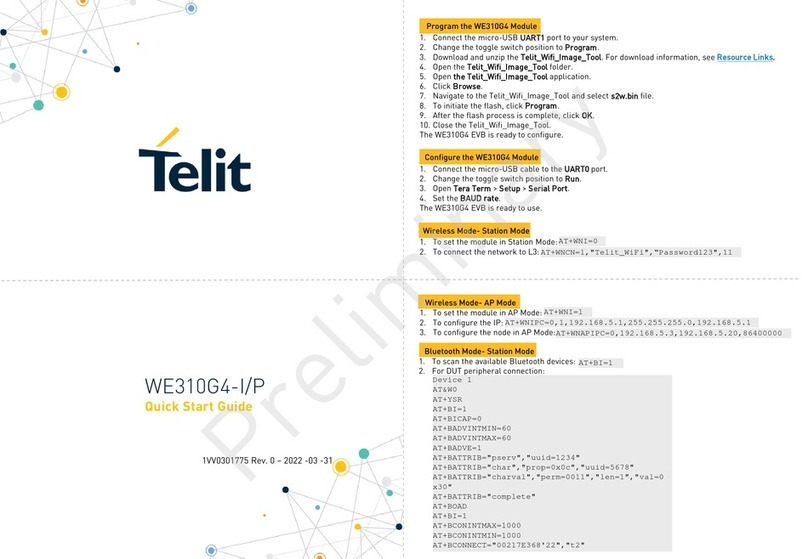
Telit Wireless Solutions
Telit Wireless Solutions WE310G4-I/P quick start guide
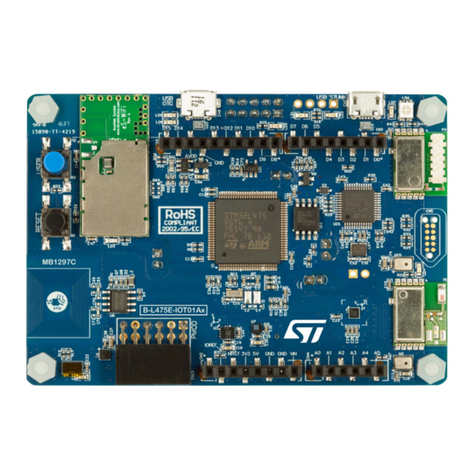
ST
ST STM32L4 Series manual
NXP Semiconductors
NXP Semiconductors LPC18xx series user manual
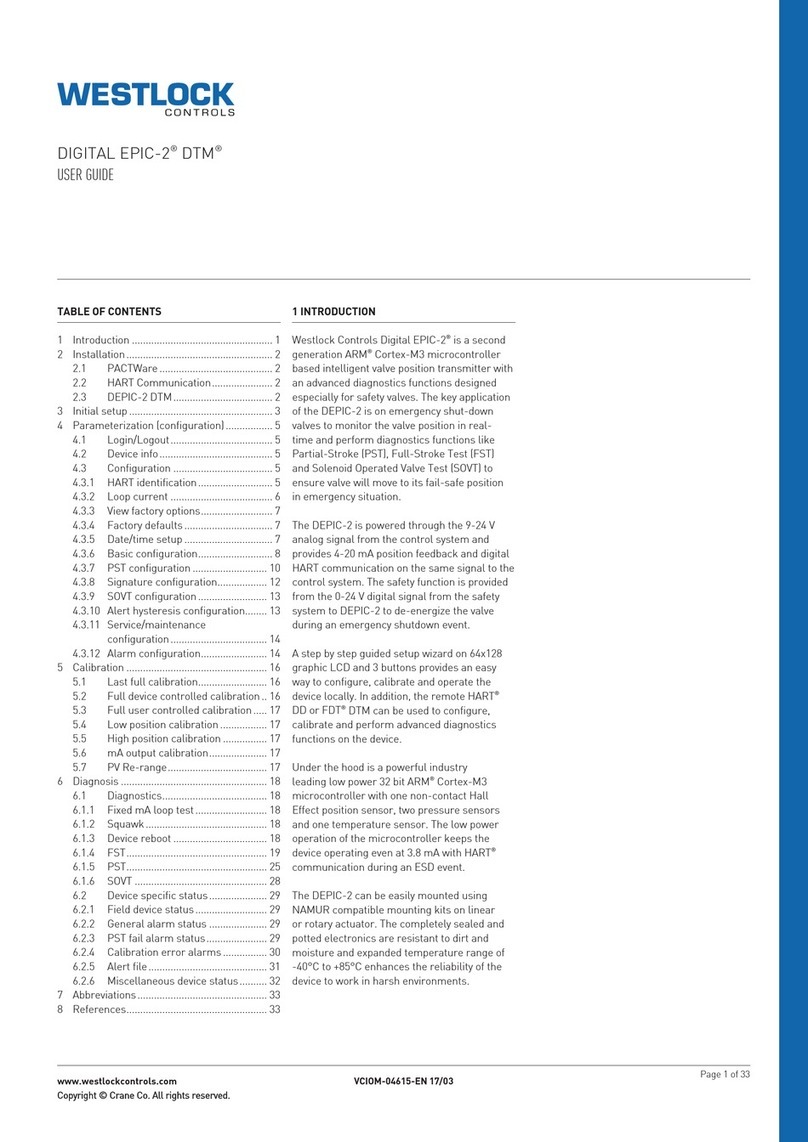
Westlock
Westlock DIGITAL EPIC-2 DTM user guide
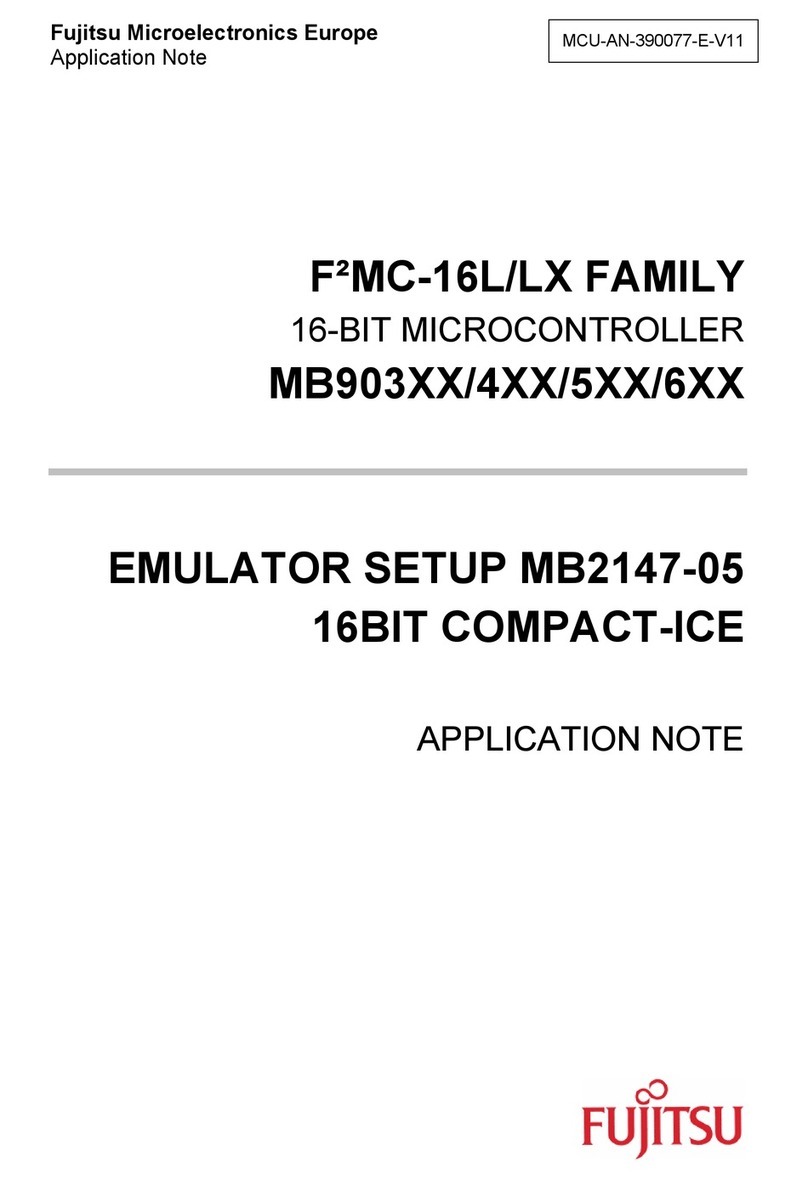
Fujitsu
Fujitsu MB904 Series Application note
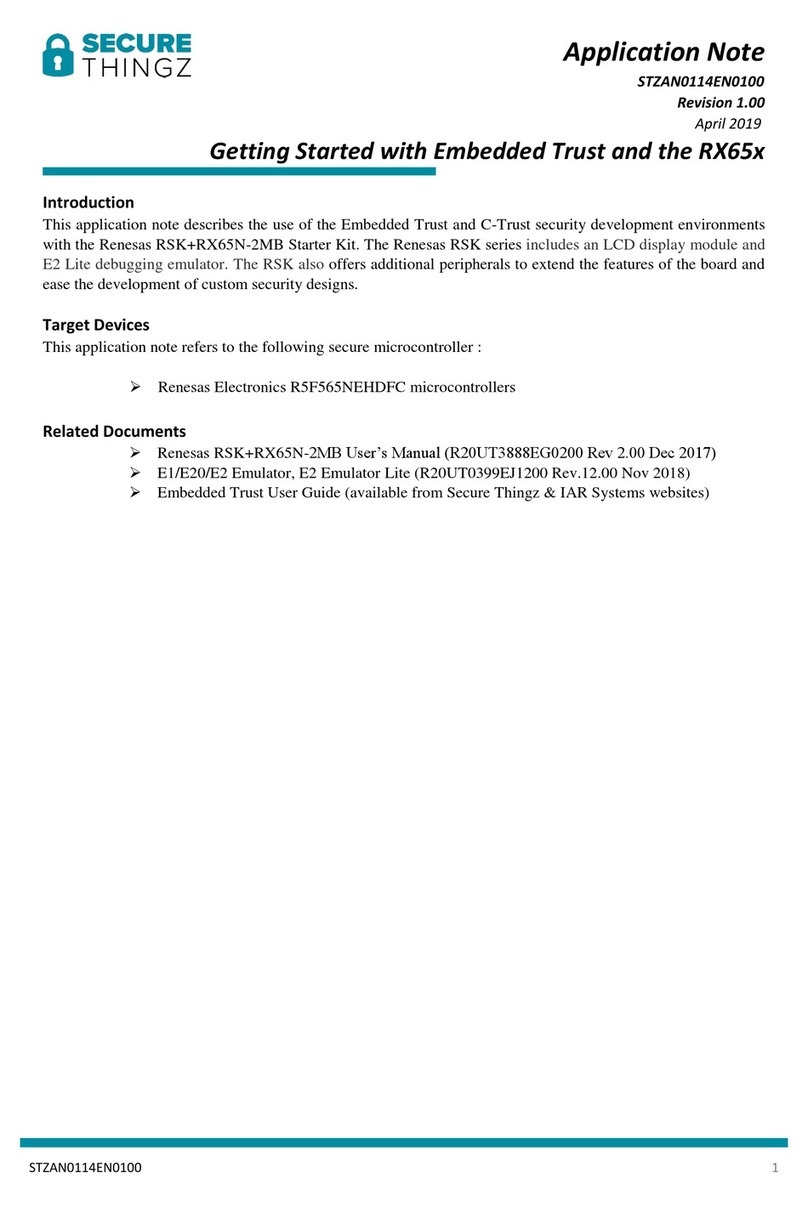
Renesas
Renesas R5F565NEHDFC Application note
